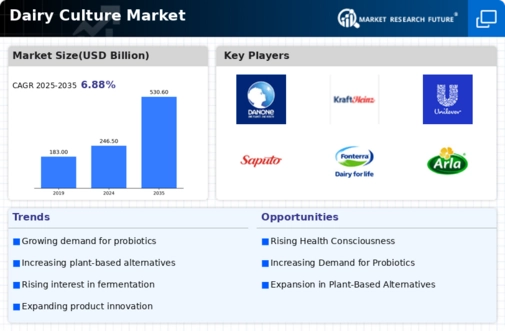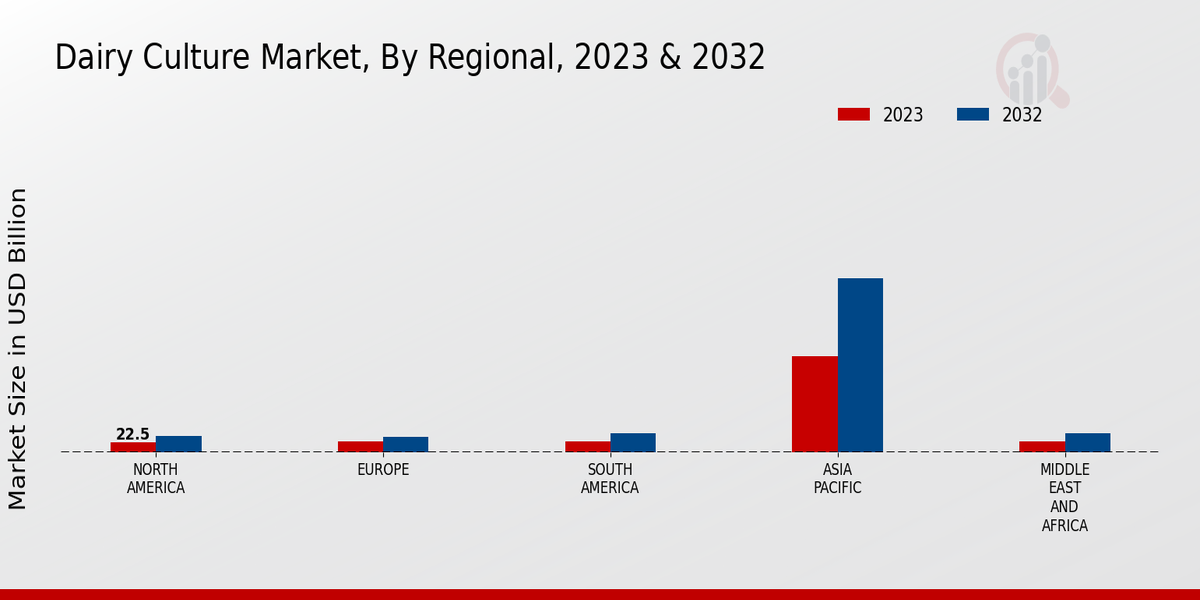Market Growth Projections
Rising Health Consciousness
The increasing awareness of health and wellness among consumers appears to drive the Global Dairy Culture Market Industry. As individuals seek healthier dietary options, fermented dairy products such as yogurt and kefir gain popularity due to their probiotic benefits. This trend is reflected in the projected market value of 246.5 USD Billion in 2024, as consumers prioritize gut health and overall well-being. The demand for functional dairy products, which offer health benefits beyond basic nutrition, is likely to expand, contributing to the industry's growth. Furthermore, educational campaigns about the advantages of dairy cultures may further enhance consumer interest.
Innovation in Product Offerings
Innovation within the Global Dairy Culture Market Industry seems to play a crucial role in attracting diverse consumer segments. Manufacturers are increasingly introducing new flavors, textures, and formulations to cater to evolving tastes and dietary preferences. For instance, the rise of plant-based alternatives and lactose-free options indicates a shift towards inclusivity in product offerings. This innovation not only appeals to health-conscious consumers but also addresses dietary restrictions, potentially expanding the market reach. The introduction of novel products may contribute to the anticipated growth, with projections indicating a market value of 530.6 USD Billion by 2035, reflecting a compound annual growth rate of 7.22% from 2025 to 2035.
Cultural and Regional Preferences
Cultural and regional preferences significantly shape the Global Dairy Culture Market Industry, as diverse culinary traditions influence dairy consumption patterns. In various regions, specific dairy cultures are integral to local cuisines, driving demand for traditional products. For example, the popularity of yogurt in Mediterranean diets and the use of buttermilk in South Asian cooking highlight the importance of cultural relevance. This diversity in consumer preferences may lead to tailored marketing strategies and product development, allowing companies to cater to specific markets effectively. Understanding these cultural nuances is essential for companies aiming to thrive in the global landscape of dairy cultures.
Growing Demand for Convenience Foods
The fast-paced lifestyle of modern consumers appears to drive the demand for convenience foods, significantly impacting the Global Dairy Culture Market Industry. Ready-to-eat and on-the-go dairy products, such as single-serve yogurts and drinkable kefirs, are gaining traction as consumers prioritize convenience without compromising nutrition. This trend aligns with the projected market growth, as the industry adapts to meet consumer needs for quick and healthy meal options. The convenience factor is likely to enhance the appeal of dairy cultures, potentially leading to increased sales and market penetration, further solidifying the industry's position in the global food landscape.
Sustainability and Ethical Practices
Sustainability and ethical practices are increasingly influencing consumer choices within the Global Dairy Culture Market Industry. As environmental concerns rise, consumers are more inclined to support brands that prioritize sustainable sourcing and production methods. This shift may lead to a greater demand for organic and responsibly produced dairy products, which could reshape market dynamics. Companies that adopt eco-friendly practices may gain a competitive edge, appealing to environmentally conscious consumers. This trend not only reflects changing consumer values but also suggests a potential for growth in segments focused on sustainability, thereby contributing to the overall expansion of the market.


 Source Primary Research, Secondary Research, Market Research Future Database and Analyst Review Dairy Culture Market
Source Primary Research, Secondary Research, Market Research Future Database and Analyst Review Dairy Culture Market










